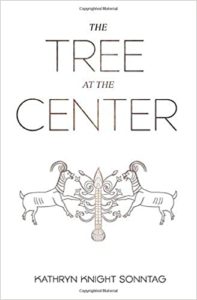 Author: Kathryn Knight Sonntag
Author: Kathryn Knight Sonntag
Title: The Tree at the Center
BCC Press, 2020. Poetry collection.
Reviewed by Lily Darais
The Tree at the Center, Kathryn Knight Sonntag’s recently published book of poetry, probes the intersections between motherhood, the natural world, and the feminine divine through the unique perspective of progressive Mormonism. Although religious allusions are particularly dominant in the book’s final section, “Asherah the Tree,” those familiar with Mormon theology will recognize its imprint throughout the poems. However, Sonntag challenges traditional religious ideas by spring-loading her theological terminology with a startlingly fresh set of connotations.
Consider her poem, “Woman of Willendorf.” In this poem, Mormon readers will immediately see a temple reference in the lines:
Tight knees will not hide
the fabric of the veil—pleasure
and pain in the fragments of red ochre
pigment tucked in your crevasses, as if
to say, here is where it matters at all—life
red as the earth, as wine, as
the flecks of blood all over my son’s
emergent body on my hollow belly.
The words “veil—pleasure/and pain” are bare references to Mormon temple rituals. The Mormon “veil” is a divinely ordained amnesia that prevents humans from recalling their pre-existence in heaven. “Pleasure and pain” likewise reference Satan’s dialogue with Eve as she contemplates eating the fruit of the Tree of Knowledge. In Sonntag’s poem, the veil becomes the slit on the Woman of Willendorf—her vagina, her personal experience of sexual pleasure and the pain of childbirth. Sonntag sees the Woman of Willendorf as a type of response to Satan’s vague promise that Eve will experience “pleasure and pain.” “Here is where it matters at all,” she writes, sketching red earth, red wine, and the red blood of birth. As the color red swirls, the poem concludes radically: “…we/are the goddesses/of the obscene.”
Sonntag turns her unique lens to similarly loaded phrases in Mormonism throughout the book. Each poem insists that female embodiment is a key to re-imagining a world healed from the imposition of patriarchy. Indeed, Sonntag asserts that the natural world, with its everlasting cycle of birth and rebirth, is, at its roots, divinely feminine. In this poetic landscape, “salvation” is union with the natural world, and “righteousness” refers to synchronicity with nature. For Sonntag, her female experience is a hierophany—a direct manifestation of an embodied, terrestrially rooted spirituality. She envisions herself as a priestess of the Great Goddess, inviting the reader to join her in holy observance of the natural world as she writes in her poem, “Cube of Fire”:
…And who
are these temple priests
slated to return—the shadow of exile
dusting their trailing robes,
palm leaves in hand—if not you,
if not me?
Restoration is a, if not the, dominant theme in Mormonism. The symbolism and repetitive imagery of a regenerative tree links the book’s title and content to a rich exploration of the idea of restoration. The Tree at the Center actually concludes with a poem about Joseph Smith’s first vision, the celebrated first event of the Mormon Restoration. Again, in this poem’s particulars and in the poetry throughout the book, the theme of restoration takes on shimmery new depth as Sonntag explores what restoration of union with a feminine divine looks like. Here the sacred grove of trees is a symbol for Heavenly Mother,
Her thousand branches adorning the long climb
into the milky stars—legs gripping
the murky underworld—
hosts and hosts and hosts and hosts.
Restoration via regeneration is, in these poems, often marked by beginnings and endings. In one poem Sonntag is pulling ghost tomatoes in December and sympathetically imagining them arguing that they can endlessly regenerate through “bone white seeds,” and in another she is looking at “‘Plate 18,’ by Unknown” and picturing the blue, oblong circle in the middle as the portal of her body, “the long receiving/of the beginning/and end.”
Of particular resonance is Sonntag’s tender poem, “As a Mother.” This poem most specifically ties regeneration to her personal experience of becoming a mother. In this poem, Sonntag touches on the losses of motherhood and her wonder of being “one working prism of Her endless/blinking body.” She writes:
I never asked to be the center,
the eternal tree,
a venus belly,
etched. But as your sweet body
latches to my breast, I
am Eve, the sun of my son—
who will carry the tree through himself
when he multiplies
and replenishes the earth.
Some might find the poems in The Tree at the Center difficult to grasp upon first read; they are not stream-of-consciousness verse, but rather a collection of erudite poems worthy of rereading, contemplation, consideration and discussion. These poems are the type that leave an attentive reader permanently changed. As a reader, I have been as deeply impacted by these poems as I have been by anything I have ever read. I mentally carry around many of the lines cited in this review, and I feel emotionally broadened after engaging Sonntag’s imagery of trees and regeneration. It is a book I have sent to many friends interested in the connection between the natural world, the Divine Feminine, and motherhood, and it is a book I recommend to all.
Lily Darais is from Evanston, Illinois, studied at Michigan State, and received a Masters in Education from Harvard. She taught high school on the South Side of Chicago for one year before getting married and having babies. She has written two guest blogs for By Common Consent, and has an essay in the NPR book, This I Believe: On Motherhood. She currently homeschools her four children.
